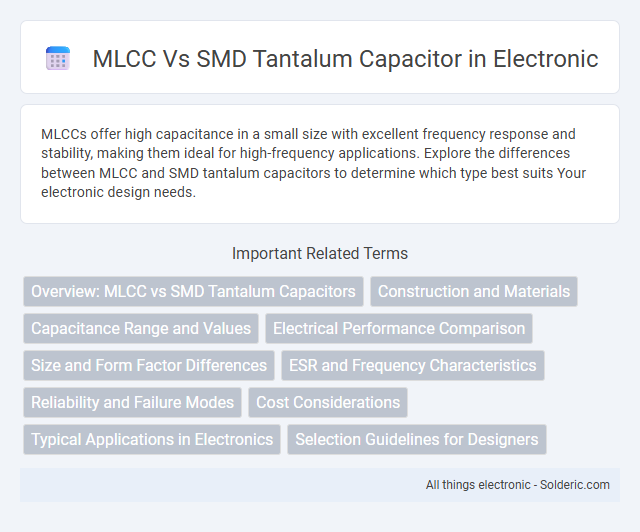MLCCs offer high capacitance in a small size with excellent frequency response and stability, making them ideal for high-frequency applications. Explore the differences between MLCC and SMD tantalum capacitors to determine which type best suits Your electronic design needs.
Comparison Table
| Feature | MLCC (Multi-Layer Ceramic Capacitor) | SMD Tantalum Capacitor |
|---|---|---|
| Dielectric Material | Ceramic | Tantalum Oxide |
| Capacitance Range | 1 pF to 100 uF | 0.1 uF to 1000 uF |
| Voltage Rating | Up to 100 V | Up to 50 V (typically) |
| Equivalent Series Resistance (ESR) | Low to Moderate | Low |
| Size | Smaller, compact | Relatively larger |
| Stability & Reliability | High stability, low aging | Good but sensitive to surge currents |
| Applications | Decoupling, filtering, high-frequency circuits | Power supply smoothing, bulk capacitance, audio circuits |
| Polarity | Non-polarized | Polarized |
| Cost | Lower cost | Higher cost |
Overview: MLCC vs SMD Tantalum Capacitors
MLCCs (Multilayer Ceramic Capacitors) offer high capacitance stability and low equivalent series resistance (ESR), making them ideal for high-frequency applications and compact circuit designs. SMD tantalum capacitors provide higher volumetric efficiency and stable capacitance over wide temperature ranges, suitable for power supply filtering where energy density is critical. Understanding the trade-offs between MLCC and SMD tantalum capacitors helps you select the best component based on capacitance requirements, size constraints, and performance needs.
Construction and Materials
MLCC (Multi-Layer Ceramic Capacitor) features multiple layers of ceramic dielectric and metal electrodes stacked to achieve high capacitance in a small size, offering excellent stability and low ESR (Equivalent Series Resistance). SMD tantalum capacitors use a tantalum metal anode coated with a layer of tantalum pentoxide as the dielectric, providing high capacitance per volume but with higher ESR compared to MLCCs. Understanding the construction and materials of these capacitors helps you select the right component for your circuit's performance and reliability needs.
Capacitance Range and Values
MLCC capacitors typically offer capacitance values ranging from a few picofarads up to several microfarads, with high capacitance density suitable for high-frequency applications. SMD tantalum capacitors generally provide higher capacitance values, often from 0.1 uF to several hundred microfarads, making them ideal for bulk energy storage in low-frequency circuits. The choice between MLCC and SMD tantalum capacitors depends on the required capacitance range and frequency characteristics of the electronic design.
Electrical Performance Comparison
MLCCs (Multilayer Ceramic Capacitors) offer low equivalent series resistance (ESR) and high-frequency performance, making them ideal for decoupling and filtering applications in modern electronics. SMD tantalum capacitors provide higher capacitance per volume and better stability in low-frequency and bulk energy storage roles but typically exhibit higher ESR and limited high-frequency response compared to MLCCs. Your circuit's electrical performance requirements should guide the choice, balancing the fast transient response of MLCCs against the capacitance density and stable voltage characteristics of tantalum capacitors.
Size and Form Factor Differences
MLCCs (Multilayer Ceramic Capacitors) are significantly smaller and thinner than SMD tantalum capacitors, making MLCCs ideal for compact and high-density circuit designs. MLCCs exhibit a flat, rectangular shape with dimensions often in the range of 0.6mm x 0.3mm to 3.2mm x 1.6mm, while SMD tantalum capacitors tend to have a thicker, pellet-like form factor with sizes typically ranging from 1.6mm x 0.8mm to 7.3mm x 4.3mm. The smaller size and lower profile of MLCCs contribute to better performance in miniaturized electronics, whereas tantalum capacitors offer higher capacitance per unit volume but with a bulkier package.
ESR and Frequency Characteristics
MLCCs (Multilayer Ceramic Capacitors) exhibit low Equivalent Series Resistance (ESR) and excellent frequency characteristics, making them ideal for high-frequency applications and noise filtering. SMD tantalum capacitors generally have higher ESR and poorer high-frequency performance due to their construction, limiting their effectiveness in RF circuits. The lower ESR and stable capacitance of MLCCs at high frequencies improve signal integrity and efficiency compared to SMD tantalum capacitors.
Reliability and Failure Modes
MLCCs demonstrate higher reliability due to their multilayer ceramic construction, which resists mechanical stress and thermal cycling better than SMD tantalum capacitors. SMD tantalum capacitors are prone to catastrophic failures such as ignitions from dielectric breakdown, largely caused by voltage spikes or polarity reversals. MLCCs mainly experience failure through cracking and capacitance loss, while tantalum capacitors often fail due to internal short circuits and electrolyte degradation.
Cost Considerations
MLCCs generally offer lower cost per unit due to high-volume automated production and widespread use in consumer electronics. SMD tantalum capacitors, while typically more expensive, provide higher capacitance values per volume and better performance in specific applications, which can justify their price for your design needs. Cost considerations should weigh initial component price against performance requirements and reliability factors in the overall project budget.
Typical Applications in Electronics
MLCCs (Multi-Layer Ceramic Capacitors) are widely used in high-frequency circuits, decoupling, and filtering applications due to their low ESR and high capacitance stability, making them ideal for smartphones, computers, and automotive electronics. SMD tantalum capacitors, known for their high capacitance-to-volume ratio and reliability under stable voltage conditions, excel in power supply filtering and energy storage within medical devices, aerospace systems, and industrial equipment. Your choice between MLCC and SMD tantalum capacitors depends on the specific voltage, temperature range, and frequency requirements of your electronic application.
Selection Guidelines for Designers
MLCCs offer high capacitance stability, low equivalent series resistance (ESR), and better frequency response, making them ideal for high-frequency applications and decoupling tasks in compact circuit designs. SMD tantalum capacitors provide higher volumetric capacitance and superior performance in bulk energy storage but require careful derating to avoid voltage and surge failures. Your choice should consider operating frequency, capacitance value, size constraints, and reliability requirements to optimize overall circuit performance.
MLCC vs SMD tantalum capacitor Infographic

 solderic.com
solderic.com